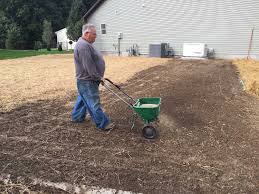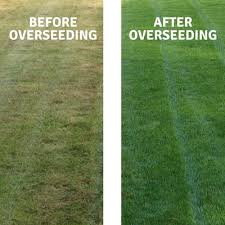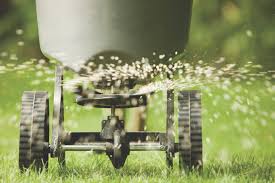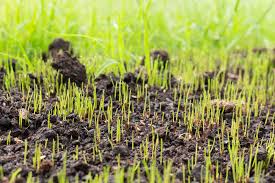Seeding a lawn is like giving your yard a new beginning. Whether you’re starting a fresh lawn or making your current one healthier, knowing how to seed it right can make a big difference.
First, pick the right kind of grass seeds. Grasses like different kinds of weather, so you need to choose seeds that like the kind of weather where you live. You can ask garden experts or people who sell plants in your area for advice on which seeds to use.
Before you put the seeds down, get the soil ready. Clean up any trash, rocks, or weeds from the ground. Then use a rake to make the soil smooth and flat. If you poke holes in the soil with a fork, it helps air and water get to the seeds better.
There are two ways to put down seeds: broadcasting and overseeding. Broadcasting means spreading the seeds evenly all over the ground. This is good when you’re starting a new lawn. Overseeding is when you spread seeds on top of a lawn that’s already there, especially on spots where the grass is thin.
To spread the seeds evenly, divide them into two equal parts. Put the first half of the seeds in one direction, and then spread the second half in a different direction. This way, the seeds are all spread out evenly.
After you put the seeds down, gently rake the soil again so the seeds are covered by a little bit of soil. This helps protect them from birds and lets them touch the soil, which helps them grow. You have to water the soil a lot now. Keep the soil a bit wet all the time until the grass is about 2 inches tall. But don’t put too much water, because that can make the grass sick.
Seeding a lawn is an essential step in creating a lush and healthy green space around your home. When the new grass starts growing, you can water it less often but give it more water each time. This helps the grass roots grow deep into the soil. Once the grass is strong, you can change how much you water based on the kind of grass you have.
Remember, growing a new lawn takes time and patience. The grass needs time to grow and fill in the spaces. If you take care of it the right way, you’ll soon have a nice, green yard that makes your outdoor area look really nice.
Read Also: Pembroke Welsh Corgi Dogs Description and Complete Care Guide
Step by Step Guide in Seeding a Lawn

Here are the steps for seeding a lawn in simpler language:
Step 1: Choose the Right Seeds
Pick grass seeds that like the kind of weather where you live. Ask experts or people who know about plants in your area for help if you’re not sure.
Step 2: Prepare the Soil
Clean up your yard by getting rid of trash, rocks, and weeds. Use a rake to make the ground flat and even. If you poke holes in the dirt with a fork, it helps air and water get to the seeds.
Step 3: Spread the Seeds
There are two ways to do this: broadcasting and overseeding. Broadcasting is like spreading salt on food. You put the seeds evenly everywhere. Overseeding is when you add seeds on top of grass that’s already there, especially where it’s thin.
Step 4: Evenly Spread the Seeds
Divide the seeds in two equal parts. Spread the first part in one direction and the second part in another direction. This way, the seeds are all spread out evenly.
Step 5: Cover the Seeds
After you put the seeds down, use the rake again to cover them with a bit of dirt. This protects them from birds and helps them touch the soil, which makes them grow.
Step 6: Water the Seeds
Make sure the soil stays a bit wet all the time until the grass is about 2 inches tall. But don’t give too much water, or the grass might get sick.
Step 7: Let the Grass Grow
When the new grass starts growing, you can water it less often but give it more water each time. This helps the roots go deep into the ground. Once the grass is strong, you can change how much you water based on the kind of grass you have.
Step 8: Be Patient
Growing a new lawn takes time. The grass needs time to grow and fill in the spaces. If you take care of it the right way, you’ll soon have a nice, green yard that makes your outdoor area look really nice.
Remember, each step you take in seeding and caring for your lawn contributes to its health and beauty. Your efforts will be rewarded with a vibrant and thriving lawn that enhances the overall appeal of your outdoor environment.
Overseeding Lawn in Spring

When springtime arrives, it brings with it the perfect opportunity to give your lawn a fresh lease of life through a process known as overseeding. Overseeding is a simple yet effective method to improve the health, appearance, and thickness of your grass by planting new grass seed over existing turf. This rejuvenating process can breathe new vitality into your lawn, helping it recover from winter stress, thinning patches, and general wear and tear.
Spring is an ideal time for overseeding because the soil is warming up, and there’s usually ample moisture available. This combination creates an optimal environment for new grass seed to germinate and establish strong roots. By overseeding in spring, you give your grass a head start before the heat of summer arrives, allowing it to develop robust root systems that can better withstand the challenges of the upcoming seasons.
Steps to Successful Overseeding
1. Prepare the Lawn: Begin by mowing your existing grass shorter than usual and raking away any debris or dead grass. This helps create better seed-to-soil contact and allows sunlight to reach the newly planted seeds.
2. Choose the Right Seed: Select a high-quality grass seed blend that suits your lawn’s conditions and requirements. Consider factors like sun or shade exposure, climate, and foot traffic.
3. Aerate the Soil: If your lawn has compacted soil, consider aerating it before overseeding. Aeration involves perforating the soil with small holes to allow air, water, and nutrients to reach the grassroots more effectively.
4. Spread the Seed: Use a broadcast spreader to evenly distribute the grass seed across the lawn. Be sure to follow the recommended seeding rate on the seed packaging for best results.
5. Fertilize and Water: Apply a balanced fertilizer after seeding to provide essential nutrients for healthy growth. Water your lawn regularly, keeping the soil consistently moist but not waterlogged. A light misting several times a day can be more effective than heavy watering.
6. Patience is Key: It takes time for the new grass seed to germinate and establish roots. Be patient and avoid mowing until the new grass reaches a height of around 3 inches.
7. Maintain and Mow: As the newly seeded grass grows, gradually increase mowing height to promote strong root development. Once the new grass is well-established, you can resume your regular lawn care routine.
Overseeding your lawn in spring offers several advantages. It helps fill in bare or thin areas, improves the overall density of your grass, enhances color and texture, and increases your lawn’s resistance to pests, diseases, and weeds. Moreover, by introducing newer, improved grass varieties, you can ensure a healthier and more attractive lawn for years to come.
In addition, overseeding your lawn in spring is a valuable investment in the health and appearance of your outdoor space. By following these simple steps, you can enjoy the rewards of a lush, vibrant lawn that enhances the beauty of your home and provides a comfortable space for relaxation and play.
Overseeding Lawn in Fall

Overseeding your lawn in the fall is a beneficial practice that can help you achieve a lush and healthy lawn next spring. Fall is an ideal time for overseeding because the soil is still warm from the summer months, which promotes germination, and the cooler air temperatures reduce stress on the newly germinated grass.
To begin, assess your lawn’s condition. If you notice bare patches, thin areas, or signs of wear and tear, overseeding can help rejuvenate those areas. Before overseeding, mow your existing grass to a shorter height than usual and remove any debris that might hinder seed-to-soil contact.
Choose the right type of grass seed that suits your climate and lawn conditions. Mixing the new grass seed with your existing grass type can help create a seamless and visually appealing result. Prepare the soil by raking the surface to loosen the top layer and improve seed-to-soil contact. Aerating the soil can also be beneficial to enhance water penetration and root development.
Evenly spread the grass seed using a broadcast spreader, following the recommended seeding rate on the seed packaging. Lightly rake the soil again to cover the seeds with a thin layer of soil. Applying a thin layer of straw mulch can help retain moisture and protect the seeds from birds.
After seeding, water the area consistently to keep the soil moist but not waterlogged. This is crucial for successful germination. As the new grass begins to sprout, gradually reduce the frequency of watering while increasing the amount of water each time. This encourages the young grass to develop deep roots.
Avoid walking on the newly overseeded areas until the grass is well-established. Depending on the grass type, you might need to wait several weeks before mowing for the first time. Once the new grass has reached a mowing height, gently mow it to encourage thickening and promote healthy growth.
Overseeding in the fall can significantly enhance your lawn’s density, color, and overall health. By taking the time to properly prepare and care for your newly overseeded areas, you’re setting the stage for a vibrant and attractive lawn in the coming seasons. Remember that patience and consistent maintenance are key to achieving the best results from your fall overseeding efforts.
Read Also: Puppies Grooming and Complete Care Guide
Overseeding Lawn

Overseeding your lawn involves spreading new grass seed over your existing lawn. This practice helps to thicken the grass, fill in bare patches, and improve the overall health and appearance of your lawn. Fall is a popular time for overseeding because the cooler temperatures and moist soil create favorable conditions for new grass to grow.
To overseed your lawn, start by mowing the existing grass a bit shorter than usual and clearing away any debris. This allows the new seeds to make better contact with the soil. Choose the right type of grass seed that matches your current grass or suits your climate.
Before spreading the seed, loosen the topsoil by raking the surface gently. You can also consider aerating the soil to create small holes that improve seed-to-soil contact. Spread the grass seed evenly using a spreader and then lightly rake the soil again to cover the seeds.
Water the seeded areas regularly to keep the soil consistently moist. It’s important not to let the soil dry out. As the new grass begins to grow, adjust your watering schedule to encourage deep root development. Be patient, as it takes time for the new grass to establish itself.
Avoid walking on the newly overseeded areas until the new grass has grown strong enough. Depending on the grass type, you might need to wait a few weeks before mowing. When it’s time to mow, do so gently to avoid damaging the young grass.
Overseeding can revitalize your lawn, making it thicker and more resilient. It’s a simple practice that can yield impressive results, giving you a healthier and more attractive lawn.
Read Also: Everything You Need to Know About Wastewater Treatment Equipment
